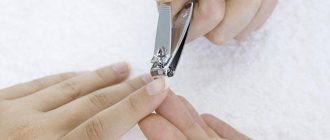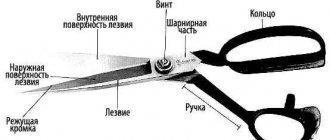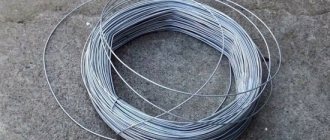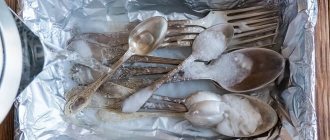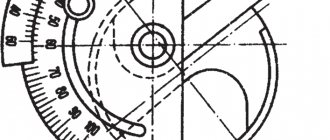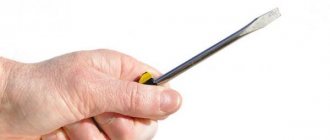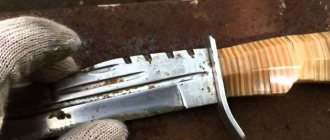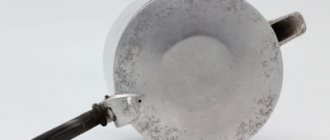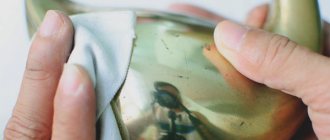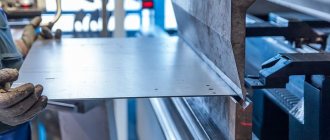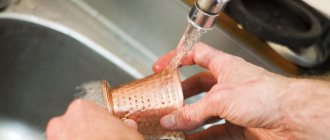This is one of the most common tools, which is available in every family for cutting all kinds of materials, but does not always perform its tasks clearly enough.
Rough operation is caused by improper sharpening of the blades or unbalanced movement of the cutting edges.
Eliminating them is quite simple for anyone with a regular set of sharpening devices. To do this, it is necessary to understand the principles of creating a cut.
The article provides advice to the home craftsman on how to sharpen scissors and adjust their blades for proper DIY work at home, with explanations along the way using pictures, diagrams and a video.
- Scissor straightening tools
To understand the principles of sharpening and setting up a tool, you should understand its design and the basics of cutting the materials being processed.
How to prepare scissors for sharpening
Before you start sharpening, check whether the performance of the blades is actually affected by dullness. Sometimes scissors may not cut well due to the loosening of the connecting element. It could be a bolt or rivet.
After fixing all the problems, cut something and thereby check whether sharpening is needed. If the blades do not cut well, you will need to sharpen them. Before use, wipe the knives with a cotton swab and an alcohol solution. Remove more stubborn stains using suitable chemicals.
How not to sharpen
The most important condition when sharpening is that you cannot change the factory angle of inclination. All beginners make this mistake. Such manipulation will affect the quality of sharpening and the ability of the tool to continue working. Often they try to sharpen the inner plane of the blade with a file. The effect in this case will be the opposite. File only the cutting edges of the tool.
- For garden shears, sharpening using foil, a needle, or sandpaper will not work. A grinding wheel or whetstone should be used;
- It is not recommended to use a gypsy needle for tailor's scissors. But, in addition to foil and sandpaper, you can use plastic bottles, which are also cut into small pieces;
- Nail scissors and stationery scissors are easily sharpened with a needle, and a sharpening wheel can quickly put them out of use, so it is not suitable.
Another common mistake is when scissors are taken apart. This cannot be done for all types of products; for example, if the blades are connected by a spring or rivet, then they should not be separated. Any inaccurate movement will cause the cutting surface to become distorted. The result of such work is that the tool will be unsuitable for use.
Self-sharpening methods at home
There are many ways to sharpen scissor blades at home. To do this, you can use improvised materials that are found in almost every apartment.
Needle or awl
To sharpen you will need a thick needle or awl. The method is quite energy-intensive, so it is suitable for processing small scissors.
Cut the selected item from the rings to the tips of the blades. Try to guide the needle along the sharp edges. Your actions should not be performed through force.
Metal sponge
You can use either new or used metal sponge. The softer the sponge, the better.
Cut the sponge with scissors, using the entire surface of the blades. The more cuts you make, the sharper the blades will be. Please note that during the procedure the sponge crumbles a lot, so it is better to cut directly above the trash can.
Glass jar or bottle
In this procedure, it is best to use an unnecessary jar, since after sharpening there will be scratches on the glass.
- Take the jar in your hand and make the required number of cutting movements. During sharpening, the entire surface of the blades should touch the glass.
- After work, carefully remove small glass fragments from the surface of the blades.
- If you need to sharpen small scissors, use a glass bottle with a narrow neck.
Foil
Take a sheet of foil and fold it into 6-8 layers. You should get a fairly dense layer. Cut the foil into small strips, using the entire surface of the blades. The duller the knives, the more cuts you need to make.
Special sharpeners
A special sharpener can be purchased at a hardware or construction department or ordered from an online store.
Open the scissors and slide each blade through the designated hole. Do the required number of passes until the blades become sharp.
Sandpaper
Like other available materials, scissors are sharpened with sandpaper by cutting it. First, fold the paper in half with the rough side facing out and cut into small strips.
The finer the sandpaper grains, the better. The ideal option would be zero-grit sandpaper.
File
Open the scissors to their maximum width and hold with your hand where the blades meet. This will allow each half to hold tightly and not become loose during the procedure.
File the inside of each blade at a 70 to 80 degree angle. Make movements either only from yourself, or only towards yourself. Never saw the blades by jerking back and forth. Just a few movements are enough to sharpen.
If you cannot hold the scissors tightly with your hand, use a vice.
Grindstone
A similar stone can be purchased at a hardware store or hardware store. Before sharpening, separate the scissors into their component parts by unscrewing the central screw. Apply each blade in turn to the stone with its sharp side and make several movements towards or away from you until the desired sharpness is achieved. At the end of the procedure, assemble the halves by connecting them with a central screw.
Grinder
To use a sharpening machine, sufficient experience and dexterity is required.
The machine is a device with a rotating abrasive wheel. Simply turn on the device and place the halves on the sharpening disc.
In the procedure, it is extremely important to know what angle must be maintained between the blade and the wheel, as well as how long to sharpen, so if you are not familiar with the device, give preference to another method.
Paper clip
Please note that the larger the paperclip, the better.
Hold the paper clip tightly with the tips of the blades and slowly, squeezing the scissors with your fingers, draw it to the base. Repeat the procedure until the scissors are sharp enough. You'll know the scissors are sharpening when you notice small nicks in the paper clip.
Battery
In a similar way to a paper clip, you can sharpen scissors using an unnecessary AA battery. Please note that the battery must be in a metal casing. Clamp the battery with the blades and move it to the base the required number of times.
Screwdriver
Since the paperclip or battery is quite small, it can be replaced with a screwdriver to sharpen larger scissors. Place the screwdriver, metal side down, on a hard surface. Pinch it with the tips of the blades and slowly move it to the base. Repeat as many times as needed to keep the blades sharp.
Where can you sharpen scissors?
Typically, this service is provided in key-making or shoe repair shops. The cost of sharpening scissors is from 50 rubles, depending on the complexity of the service.
Application of diamond wheel
If professional instruments are not available, the processing can be carried out using a diamond wheel. This method is more suitable for processing small or fragile items. Its features include the following points:
- You should work with a diamond wheel carefully, as mistakes made can cause a change in the sharpening angle. If you change the sharpening angle, the scissors will become unusable.
- It is recommended to set the device used to minimum speed. Sharpening should be done smoothly starting from the tip. Do not press too hard on the workpiece.
- It is not always possible to sharpen the blade in one go. Processing is carried out until the required result is achieved.
Instead of a diamond wheel, you can use a diamond nefil . To sharpen nail scissors, you should use two types of diamond nefil: first, processing is carried out with a coarser grain, then with a fine-grained tool. By using abrasives with different grain sizes, you can achieve better results.
Subtleties of the sharpening process
Depending on the type and purpose of the scissors, sharpening may have some subtleties and nuances.
Regular
Scissors that cut paper or other materials can be sharpened at home, spending very little time. Use foil, sandpaper, or another metal-coated object to sand the blades.
Kitchen
At home, it is best to sharpen kitchen scissors in a way that does not require disassembling them. Foil, sandpaper or metal sponge work well. However, such sharpening will not provide long-term results. For better processing, contact professionals.
Manicure
High-quality manicure scissors are quite difficult to sharpen at home. To do this, you need to know how to properly tighten the connecting element and what the sharpening angle should be. The blades are processed with a special diamond needle file from base to tip.
Hairdressers
Hair cutting scissors are made from high-quality materials, as they are designed for a long service life. Properly sharpening blades at home is very difficult and risky. Entrust sharpening to a professional who uses special laser equipment for the job.
Thinning
Thinning scissors have a special structure. They consist of double blades - serrated and straight. It is impossible to sharpen such an item at home, since the work requires certain equipment and knowledge.
Tailor's
It is extremely important when sharpening fabric scissors not to leave jagged edges on the blades, so use smoother materials for processing, such as foil or zero-grade sandpaper. After sharpening, be sure to check the quality of the cut on an unnecessary piece of fabric.
If these are zigzag scissors for processing the edges of fabric, then they can only be sharpened in a workshop.
Garden
For sharpening, you can use a whetstone or a machine. Disassemble the scissors into their component parts and sharpen them accordingly.
Metal scissors
To process metal scissors, be sure to maintain a sharpening angle of approximately 75 degrees. In preparation, separate the blades by unscrewing the connecting bolt. You can sharpen knives with a file or sandpaper. After the procedure, treat the parts with an anti-corrosion agent to extend their service life.
Sheep
Such scissors require maximum sharpness, so processing with foil or sandpaper will not work. Blades must be sharpened using a machine with an abrasive wheel. Process each blade separately, opening the halves as wide as possible.
Non-separable
Scissors cannot be disassembled without a connecting bolt. For sharpening, choose simple methods that do not require separating the halves, such as using a needle, foil or sandpaper.
Cutting edges of scissors blades
Any scissors cut fabric with the edges of the blades indicated by the arrow. The angle of these edges may vary depending on their purpose. These scissors in the photo are intended for office work, and therefore the angle is almost 90 degrees. However, sharp and serviceable scissors should also cut fabric.
But in this case, they do not cut the fabric at all, but only squeeze it between the blades. By the way, tailor's scissors need to be checked on the thinnest fabrics, such as chiffon or silk. If scissors cut such fabric, not only with the blade, but also with their tips, then they are perfectly sharpened.
Why don’t these scissors, which look quite sharp, cut fabric? There may be several reasons, the simplest of which is that the fastening of the blades has become loose. The gap between the cutting edges has increased, and the thin fabric is simply pinched, but not cut. Let's try to tighten the screw connecting the blades and try to cut the fabric.
What not to do when sharpening scissors
To avoid ruining the sharpness of the blades:
- Do not try to sharpen non-standard scissors (hairdressing scissors, thinning scissors, manicure scissors) yourself. Their sharpening requires the use of professional equipment.
- Maintain the sharpening angle corresponding to the factory one. If handled incorrectly, the blades will become unusable.
- Do not disassemble the scissors if you are not sure that you can put them back together.
How and with what to sharpen manicure scissors for cuticles?
In general, experienced manicurists have their tools sharpened. It is worth noting that rough sharpening using large abrasive particles can damage cuticle tweezers and scissors. Therefore, if you have an expensive and professional instrument, we recommend that you give it to a professional. Such tools are often sharpened using a laser.
Instructions:
- The operation is performed with a diamond file
- It is necessary to move the file with gentle pressure towards the tips of the scissors
- In this case, under no circumstances should the sharpening angle be violated.
How and with what to sharpen manicure scissors for cuticles?
Why don't scissors cut?
It happens that the blades retain their former sharpness, but the scissors still do not cut. In such cases, you need to check for a gap between the knives and also see if the cutting edge is broken.
How does a gap occur?
Due to increased loads, over time, the connection of the halves weakens slightly and a gap appears between the blades. Sometimes it happens that the metal of the knives becomes slightly deformed. To ensure that the scissors cut well again, adjust the mount or align the blades.
Cutting edge irregularities
Over time, the metal of the blades wears out and becomes deformed. To level the cutting edge, you should contact a professional craftsman who will sharpen and polish the surface of the edge.
How to adjust blade stroke
To adjust the fastener that affects the gap:
- If it is a bolt, carefully tighten it using a small screwdriver. Be careful not to over-tighten; if you tighten too much, the halves won't be able to move.
- If the connection is a rivet, open the scissors and place it on a metal surface. Then use a few blows of a hammer to flatten the plug.
- If there is a stop at the junction of the halves, open the scissors and carefully sharpen it.
Rules for working at home
Regardless of what tool is used, you need to know how to sharpen metal scissors at home correctly to get a good result
It is important to know 4 rules:
- It is necessary to take into account the factory sharpening angle. Self-sharpening of manicure or other scissors is carried out only at the established angle. If you break the rule, you can permanently damage the tool for manicure and cuticle trimming.
- The tool sharpens towards itself. Movements must be constantly controlled; you cannot sharpen the side cutter using back and forth movements. Tools can be sharpened from the nose to the rings.
- Fighting burrs. If there are burrs after sharpening, they are removed with a fine-grained abrasive. The only exception is hairdressing equipment; it cannot be made too sharp.
- Checking the work. It is made according to the material for which the tool is intended. For example, if tailor scissors have been sharpened, they need to be checked on the fabric. A thin piece of fabric is taken, hung and cut. If the cut is smooth and pieces of fabric are not caught, it means the job was done correctly.
If the design of the scissors allows, then it is better to disassemble them to simplify the task of how to sharpen nail clippers at home. The blades are sharpened separately, so it is more comfortable to work, and the result is better.
How to keep scissors sharp at home
To keep your blades sharp for as long as possible, follow these simple rules for using them:
- Do not use boiling to disinfect. It is better to wipe the blades with an antiseptic.
- Treat the mechanism for connecting the halves with any oil once every 6 months.
- Use scissors only to cut materials that are suitable for their intended purpose.
Always wipe the blades with a piece of cloth after use. Store scissors in a special case and do not allow liquids to come into contact with the knives.
Proper care of scissors in the future
Your scissors will not require sharpening or repair for a long time if you follow the basic conditions of proper storage and use. The special tool should only be used for its intended purpose. Cutting blades should be cleaned regularly with cleaning agents and disinfectants.
At least twice a year, the fastening and connecting mechanism should be lubricated with machine oil. After each use, be sure to wipe the blades with a dry, clean cloth. Professional tools should be stored in a protective case and should not be exposed to moisture, dust or contamination.
Sources
- https://sdelai-lestnicu.ru/obustrojstvo/kak-natocit-noznicy-v-domasnih-usloviah-7-effektivnyh-sposobov
- https://WikiMetall.ru/metalloobrabotka/kak-natochit-nozhnitsyi-v-domashnih-usloviyah.html
- https://instrument16.ru/zatochka/kak-potochit-manikyurnye-nozhnitsy-v-domashnih-usloviyah.html
- https://ubirai.ru/raznoe/kak-natocit-noznicy-v-domasnih-usloviah-manikurnye-i-parikmaherskie.html
- https://baltija.eu/2021/05/08/kak-natochit-nojnicy-vozmojnye-sposoby-borby-s-typostu-instrymentov/
- https://heaclub.ru/kak-i-chem-natochit-nozhnicy-domashnie-manikyurnye-parikmaherskie-filirovochnye-portnovskie-sadovye-po-metallu-ovechi-prosto-bystro-i-dostupno-v-domashnih-usloviyah- kak-natochit-nozhnicy-igol
- https://hoznauka.ru/poleznye-sovety/kak-natochit-nozhnicy.html
- https://1000sovetov.ru/article_krasota-v-vashikh-rukakh-kak-zatochit-manikyurnye-nozhnicy
- https://math-nttt.ru/stanki/kak-zatochit-shchipchiki-dlya-nogtej.html
- https://janet.ru/404972a-kak-zatochit-manikyurnyie-nojnitsyi-v-domashnih-usloviyah-zatochka-manikyurnyih-instrumentov
- https://heaclub.ru/prichiny-pochemu-nozhnicy-mogut-ploho-rezat-kak-natochit-nozhnicy-samostoyatelno-osnovnye-pravila-kak-zatochit-nozhnicy-v-domashnih-usloviyah-oselkom-bruskom-tochilnym- kamnem-nazhdachnoj-bumag
- https://DomZastroika.ru/byt/kak-zatochit-nozhnitsy-v-domashnih-usloviyah.html
How to remove rust from scissors
If the metal is covered with rust, it can be removed using special or improvised means. Special substances easily cope with plaque and do not spoil the metal. However, such funds are not always available at hand, and they are quite expensive.
An alternative to store bought substances can be substances that are available in almost every apartment. You can remove rust with:
- slurry of water and soda;
- solution of citric acid or vinegar;
- peeled potatoes.
If the rust has not yet become deeply ingrained into the metal, the blades can be cleaned with sandpaper or a metal sponge.
Scissors are a simple item that requires simple operating rules. Some types of them require special sharpening only in professional workshops. To process regular blades, you can use materials that are always on hand. At the same time, the procedure does not require any special skills from you, and also will not take much effort and time.
Needle sharpening method
In most cases, it is necessary to sharpen the scissors if there are no special tools at hand. The way out of this situation is often to use a regular needle.
This method of sharpening a metal product involves performing the following work:
- Stretch the two halves as wide as possible.
- The needle is placed near the section.
- The two halves of the scissors are gradually brought together. Naturally the needle moves forward.
It is recommended to repeat this procedure 2-3 times . When making a needle, hard metal is usually used. Upon contact with the cutting edge, a layer of metal is removed from the surface being processed. Naturally, the needle is positioned at the desired angle relative to the cutting edge.
Checking the quality of the cut
In order to evaluate the functional characteristics of the scissors, it is necessary to carry out a preliminary test. It is necessary to cut the materials five times:
- To check household, industrial or school scissors, flannel or a cotton pad is suitable;
- checking hairdressing scissors or thinning hair is checked with tissue paper;
- Wrapping paper is suitable for testing office scissors.
The cut must be smooth, the material to be cut must not be wrinkled or torn. The blades of the scissors after the procedure must retain their cutting properties and not become dull. Do not forget that the functioning of the tool is influenced not only by the cutting performance, but also by other important factors. Another reason for deterioration in the quality of scissors may be the weakening of the fastening bolt or rivet.
Checking the cutting quality of scissors
Once such a flaw is discovered, it must be eliminated and only then begin checking the cutting characteristics of the scissors. Before testing the tool in practice, it is advisable to wipe the sharpening corners of the tool with a cotton pad soaked in alcohol. This is done in order to clean the surface of the scissors from barely visible contaminants that may interfere with full contact of the cutting edges and impair the quality of work.
The process of sharpening manicure tools
Masters of the “Sharpening Studio” carry out inspections and complete repairs of the following types of manicure devices:
· Manicure scissors (nail, cuticle);
· Nail and cuticle nippers;
· Blades (scrapers, pushers);
· Nail clippers (nippers).
In addition to such services, our masters provide training (a pedagogical process as a result of which students, under the guidance of a teacher, acquire knowledge, skills and abilities)
sharpening of manicure instruments
, in which they transfer all their existing knowledge in this industry.
When sharpening manicure instruments, the master inspects the process of free movement of the working part of the device. With all this, the simultaneous and harmonious closing and opening of the surface of both sides of the scissors is determined. Later, the master bends the edges of the cutting part of the tool. This is done with the aim of tightly closing the edges of the scissors. Then, using diamond sharpening, the edges are sharpened.
About how to sharpen manicures
wire cutters, our experts will tell you. They know that repeated sharpening of such a tool is the key to a successful and flawless manicure. After all, poorly sharpened nippers can become not only a prerequisite for flaws, but also various infections and diseases. Our craftsmen first clean the tool and remove all bulges from the cutting part. Also lubricate the joints of the handles. The sharpening itself takes place by sequentially sharpening both sides of the nippers. At the end, the nose of the tool is sharpened for perfect work.
Besides the question of how to sharpen nail scissors
and wire cutters, our craftsmen know the answer to the question about sharpening a wire cutter. Such tweezers need to be sharpened quite often so that they do not cause discomfort during manicure. Before the procedure itself, they are cleaned of dirt and rust, and then the edges are smoothed. Then, with the help of diamond sharpening, the process itself occurs. If necessary, the joints in the clippers are lubricated with oil.
Professional sharpening of manicure tools
requires thoroughness in work, special experience and, of course, special devices.
Tips from our experts on caring for manicure tools
In order for manicure devices to serve for a long time, they need to be properly cared for. For this, first of all, prevention is needed. To sharpen the tweezers
, scissors and clippers are not useful, you should not leave the tool in a visible place in the house or salon. Sterilize your instruments only with gentle sterilizers, and do not leave them in there. If necessary, lubricate your instrument in suitable places with oil.
To avoid the need for sharpening scissors
, do not drop them onto the shelf surface. If there is a need to put the manicure tool outside of its case, then place it with the blade up, not down. Under no circumstances should scissors, wire cutters, or knives be thrown anywhere, as this will cause their edges to bend and become dull. To transport instruments, use special cases and tips. Agree that special cases purchased at the right time will save your money on instrument repair.
Remember that frequent sharpening of wire cutters
will not be useful if you use them for their intended purpose. If you use them for household needs, they can simply break. Do not use your personal manicure equipment to trim the nails of pets. A very significant point is that you don’t have to try to sharpen the tool yourself, because you can simply break it, and then you will need to waste money on new devices. From time to time they bring to us scissors and wire cutters that were sharpened at home without knowing all the technology. And often it is necessary to return it back due to the impracticality of repairs. Our specialists also sharpen machine knives, saw chains, planes, sharpen axes and almost everything else.
The service life of any tool sooner or later comes to an end and one cannot envy a master who is accustomed to working with it. There are nicks on the scissors, and the machine stubbornly skids on the back of the client’s head; with the help of a manicure tool it is now better to dig in the garden, but with tweezers you can only stretch out the splinters - the tool is hopelessly dull. It seems that it is no longer possible to create anything and you will have to throw out a proven “friend” who has served you for a long time. But there is no need to rush, because all you have to do is turn to our specialists, who will sharpen any instrument and bring it back to life.
Highly qualified craftsmen with extensive experience will complete the job of any difficulty. After all, in order to become specialists in their own field, they had to study a lot. If you have dealt with sharpening tools, then it is clear to you that there is no single idea about how to perform such work. This cannot be learned at school or technical college. Our workers learned their skills by sharpening tons of alloy. They practiced production techniques on ordinary products and tools, gradually switching to professional ones, the sharpening of which requires the highest precision and knowledge. So now you can relax and trust us with your tools.
It will not be difficult for our craftsmen to create professional sharpening of cutting tools: kitchen knives and scissors, hairdressing tools, hand-held clippers, meat grinder knives. Any tool is not simply sharpened, but also ground and polished using special abrasives and pastes. And the better the last step is performed, the longer the blade will remain sharp. Remember that correcting an incorrectly sharpened blade is much more difficult, and sometimes completely unrealistic, especially with a manicure tool.
Sharpening, grinding and polishing of instruments is carried out using professional equipment. Our employees, specialists of the highest class, understand that a perfectly sharpened tool is the productivity of your work, its properties and ability to cope with the job in record time.
-SHEET
Manicure scissors
The corresponding highlight of this tool is the curved blades of a curved shape. It is better not to start processing them without good metalworking skills and round fine-dispersed diamond-coated needle files.
If your nail scissors start to work poorly, try this first:
- tighten the screw-shaped fastening of the rotation axis;
- inspect the gap between the cutting edges of the leads;
- polish with a needle.
I recommend editing twists only in the latter case, using a special tool.
To consolidate the material, I recommend watching the video by Serg578 “Refining the blade of scissors in 2 touches.”
Prices for sharpening hairdressing instruments
The cost of services for sharpening hairdressing tools will delight you with its loyalty and awareness of the needs of clients. Only with us you can get the full range of necessary services for such a reasonable fee and be confident in the outcome you have purchased.
Sharpening hairdressing tools in Moscow is an important step. The demands of the capital's inhabitants are high; to satisfy them, the hairdresser must not only meet them skillfully, but also have the necessary technical base. Tasks can disappear forever if we are nearby.
| Sharpening cuticle nippers | 300r./250r. from 4 pcs |
| Sharpening nail clippers | 300r./250r. from 4 pcs |
| Sharpening nail clippers | 200 rub. |
| Sharpening cuticle scissors | 250 rub. |
| Sharpening manicure blades (scrapers, pushers) | 150 rub. |
| Sharpening nipsers (nail clippers) | 100 rub. |
| Sharpening the incisors | 150 rub. |
| Rust removal | Free of charge |
| Replacing the wire cutter spring | 100 rub. |
Both manicurists and those who simply have a manicure set sometimes need sharpening of their manicure tools.
. The specialists at the Sharpening Center provide such services very well and at a reasonable cost.
Professional sharpening of hairdressing tools
A well-carried out sharpening of a hairdressing instrument is not as common in Moscow as one would like. Curved or thinned edges, removal of 3-4 mm of the working surface and other problems can await cooperation with amateurs.
Experienced craftsmen and responsible persons of large salons know unsurpassedly that calling our workshop is a smart and profitable choice. We would like to offer sharpening of hairdressing tools in a complete set or in single copies. Straight, thinning, slicing, hot scissors, and knives from a hair cutting machine are used.
Fast and high-quality professional sharpening of hairdressing tools is possible thanks to the highest qualifications of our employees and the modern equipment used by our company. Machines for sharpening hairdressing tools by themselves cannot provide a sufficient level of results. Only a carefully selected team can make every hairdresser's dream come true - impeccable conditions for creativity, ease of every movement.
